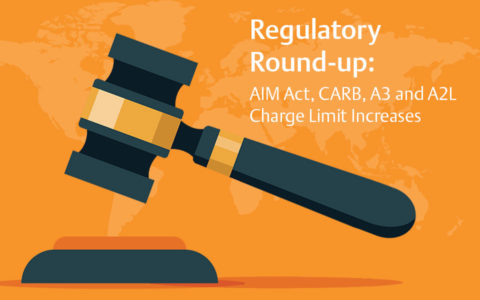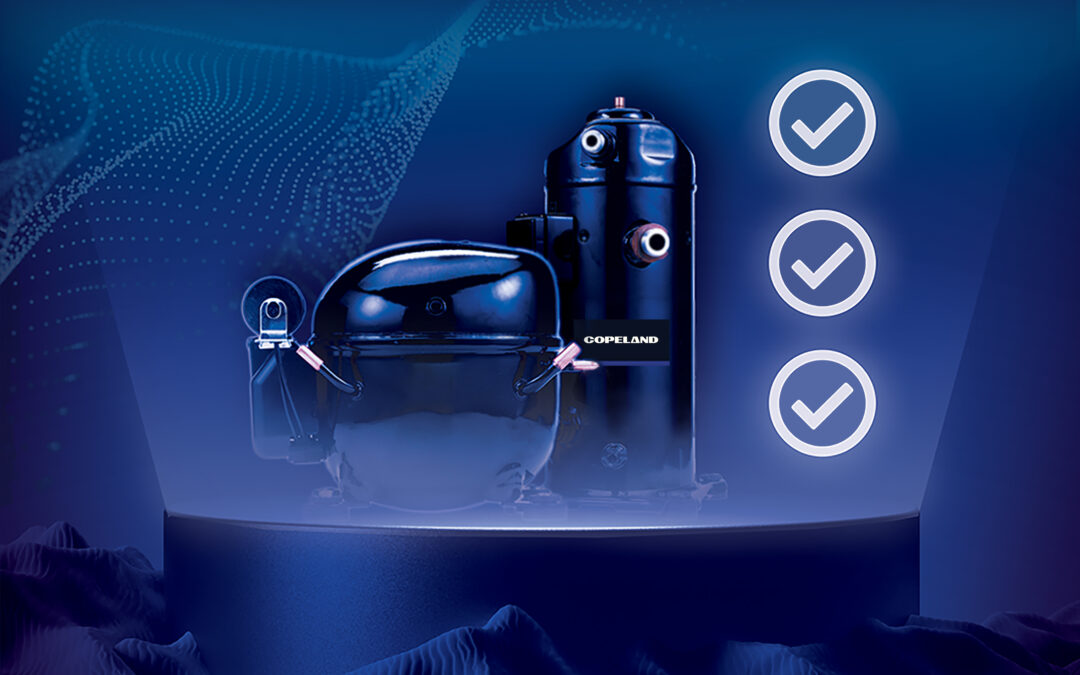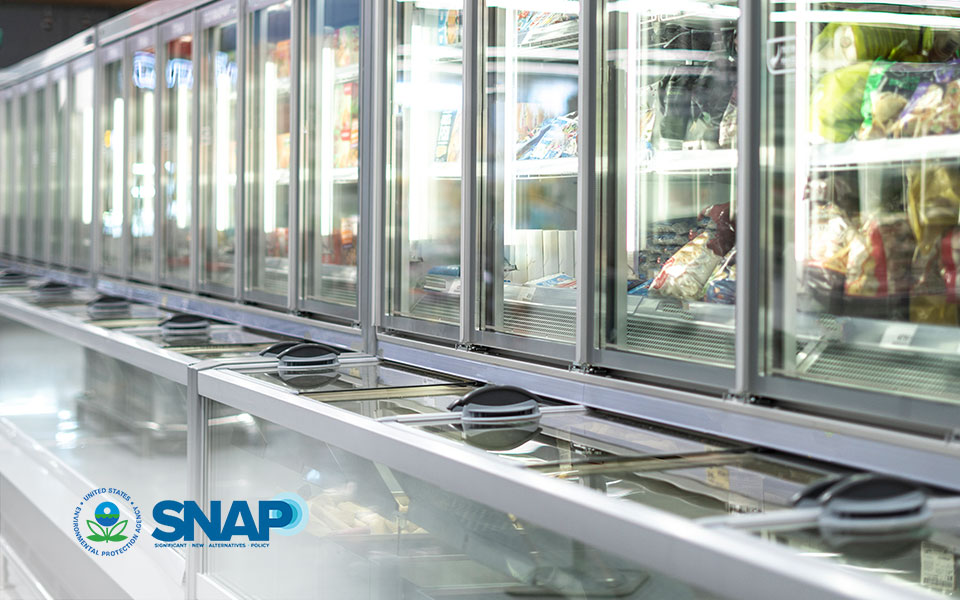Regulatory round-up: AIM Act, CARB, A3 and A2L charge limit increases

*On June 1, 2023 Emerson’s Climate Technologies business became a new standalone company – Copeland. Though our name has changed, we are building on more than a century of HVACR innovation and industry leadership, and Copeland continues to offer the same products, industry stewardship, and learning opportunities you’ve grown to trust. Information found on this webpage posted before June 1, 2023 may contain our old name or branding, but you can be at ease knowing it was created with the knowledge and expertise of Copeland.
If you’re like many stakeholders in the commercial refrigeration industry, you know how important it is to keep track of the dynamic regulatory climate. From making refrigerant decisions and selecting next-generation equipment to planning for compliance and meeting sustainability goals, many companies are basing some of their most important decisions on these developments. I recently provided an article to HVACR Business that reviewed several key regulatory updates taking place this year. If you’re hoping to bring the sometimes-confusing regulatory picture into clearer focus, hopefully this will help. You can also view our formatted article here.

AIM Act establishes federal HFC legislation
Signed into law in late 2020, the American Innovation & Manufacturing Act (AIM Act) gave the Environmental Protection Agency’s (EPA) authority to regulate hydrofluorocarbon (HFC) refrigerants in three primary ways:
-
- Phasing down HFC refrigerant supplies by reducing their production and consumption over a 15-year period. Supply-side restrictions began on Jan. 1, 2022, requiring a 10% reduction in HFC production and consumption through 2023. An additional 30% reduction will take effect between 2024 and 2028 with 70% and 80% reductions needed by 2029 and 2034, respectively. These phasedowns are expected to drive up HFC prices significantly as supplies decrease.
- Establishing sector-based approvals and HFC restrictions to support the industry-wide transition to lower-global warming potential (GWP) refrigerant technologies. Use restrictions will enable specific sectors to transition more quickly while providing additional flexibility for those who may need more time. The EPA can approve new lower-GWP alternatives per sector-based rulemakings, which are expected to be begin in 2022.
- Regulating HFC management by establishing and enforcing standards in servicing and repair best practices, such as: lowering leak rate thresholds and requiring proper recovery of “used” HFCs for purification and resale (aka reclaim). Previously, the EPA had created Section 608 to govern these best practices; we expect their revised HFC management rulemaking could be built off the Section 608 framework.
CARB rulemaking takes effect
After several years of collaboration with state and HVACR industry stakeholders, the California Air Resources Board’s (CARB) proposed rulemaking became final in late 2021 and went into effect on Jan. 1, 2022. The final rule establishes HFC phasedown requirements for new and existing facilities, including a company-wide provision for food retailers operating with a fleet of existing stores within California.
-
- New facilities — Installation of new refrigeration systems containing more than 50 pounds of refrigerant are required to use refrigerants with less than 150 GWP.
- Existing facilities — Refrigeration equipment containing more than 50lbs of refrigerant in existing facilities are subject to company-wide, fleet GWP reduction targets by 2030 compared to their 2019 baselines — with two potential paths to compliance: 1) Weighted-average GWP (WAGWP) reduction <1,400 GWP by 2030, where WAGWP is the sum of the total refrigerant charge of every system greater than 50 pounds in every store in California; 2) Greenhouse gas emissions potential (GHGp) reduction by 55%, where GHGp is the sum of the total refrigerant charge of every system greater than 50 pounds in every store in California multiplied by the GWP values of the refrigerant types in use.
Regarding new stationary air conditioning (AC) equipment, refrigerants with a GWP greater than or equal to 750 will be prohibited, starting in 2025.
Evolving safety standards for flammable (A3) and mildly flammable A2L refrigerants
Governing bodies that regulate the safe use of refrigerants in the U.S. have long been evaluating the prospect of increasing charge limits in the flammable A3 (propane, aka R-290) and mildly flammable A2L refrigerants. In 2021, the Underwriters Laboratories (UL) approved the second edition of its UL 60335-2-89 standard, which included higher charge limits that would expand the potential uses of R-290 and A2Ls in commercial refrigeration.
R-290 charge limit increases — R-290 has a long-held maximum charge limit of 150g and has primarily been used in smaller, self-contained units. The updated UL standard raises the charge limits on these commercial stand-alone displays based on whether they have an open or closed design:
-
- 500g maximum charge limit in open appliances (without doors)
- 300g maximum charge limit in closed appliances (with doors or drawers)
From an application design perspective, higher charge limits will help to increase system capacities while capitalizing on R-290’s high efficiency and low-GWP rating (GWP = 3).
A2L charge limit increases — Per the recently updated UL 60335-2-89 safety standard, new A2L charge limit guidelines have been established for self-contained and remote refrigeration systems. For self-contained equipment, charge limits are determined on equipment design (e.g., open or closed with doors or drawers). Degrees of flammability will vary among different A2L refrigerants, so it’s important to calculate charge limits based on the specific A2L characteristics.
For example, R-454C has a lower flammability limit (LFL) of 0.291 kg/m3, thus:
-
- A closed-door case can be charged with up to 2.33 kg (5.1 lbs.) of R-454C.
- An open case with R-454C can be charged with up to 3.78 kg (8.3 lbs.) of R-454C.
- In remote or field-erected systems, UL 60335-2-89 supports R-454C charge sizes up to 75.7 kg (166 lbs.) per circuit.
The updated standard requires remote A2L systems to be designed with requisite safety strategies and mitigation measures to keep gas concentrations below flammable thresholds:
-
- Leak detection at various points of the refrigeration circuit (e.g., compressor, condensing unit and case)
- Action plans that immediately mitigate flammability risks
The UL 60335-2-89 second edition update is only the first step in a larger series of regulatory approvals needed to enable higher charges of R-290 and the use of A2Ls in U.S. commercial refrigeration. Additional regulatory and/or policy changes will also need to be approved:
-
- EPA Significant New Alternatives Policy (SNAP) approval of specific A2L refrigerants and increased R-290 charge limits
- ASHRAE 15 safety standard update for refrigeration systems
- Model code updates in the upcoming code revision cycle, such as: Uniform Mechanical Code (UMC), International Mechanical Code (IMC) and International Fire Code (IFC)
- State and local building code updates
In the meantime, installing an A2L-based refrigeration system would typically require the approval of local authorities having jurisdiction (AHJ), such as fire marshals and/or building inspectors.
To stay informed of the latest regulatory updates that could impact your operational decision making, please visit our regulations hub.

A2L refrigerant regulation updates: what you need to know today
by Jennifer Butsch | Efficiency & Refrigerant Regulations
Preparing for the approval and safe use of A2Ls in commercial refrigeration applications The move...

Address Efficiency Mandates with Compression Technologies
by Joe Summers | Efficiency & Refrigerant Regulations
Strategies for complying with DOE and ENERGY STAR® in self-contained and remote condensing units...

EPA SNAP Rule 26 Approves, Modifies Use Conditions for A2L and A3 Refrigerants
by Jennifer Butsch | Efficiency & Refrigerant Regulations
On May 28, the Environmental Protection Agency (EPA) pre-published its Significant New...
The post Regulatory Round-up: AIM Act, CARB, A3 and A2L Charge Limit Increases appeared first on Copeland.